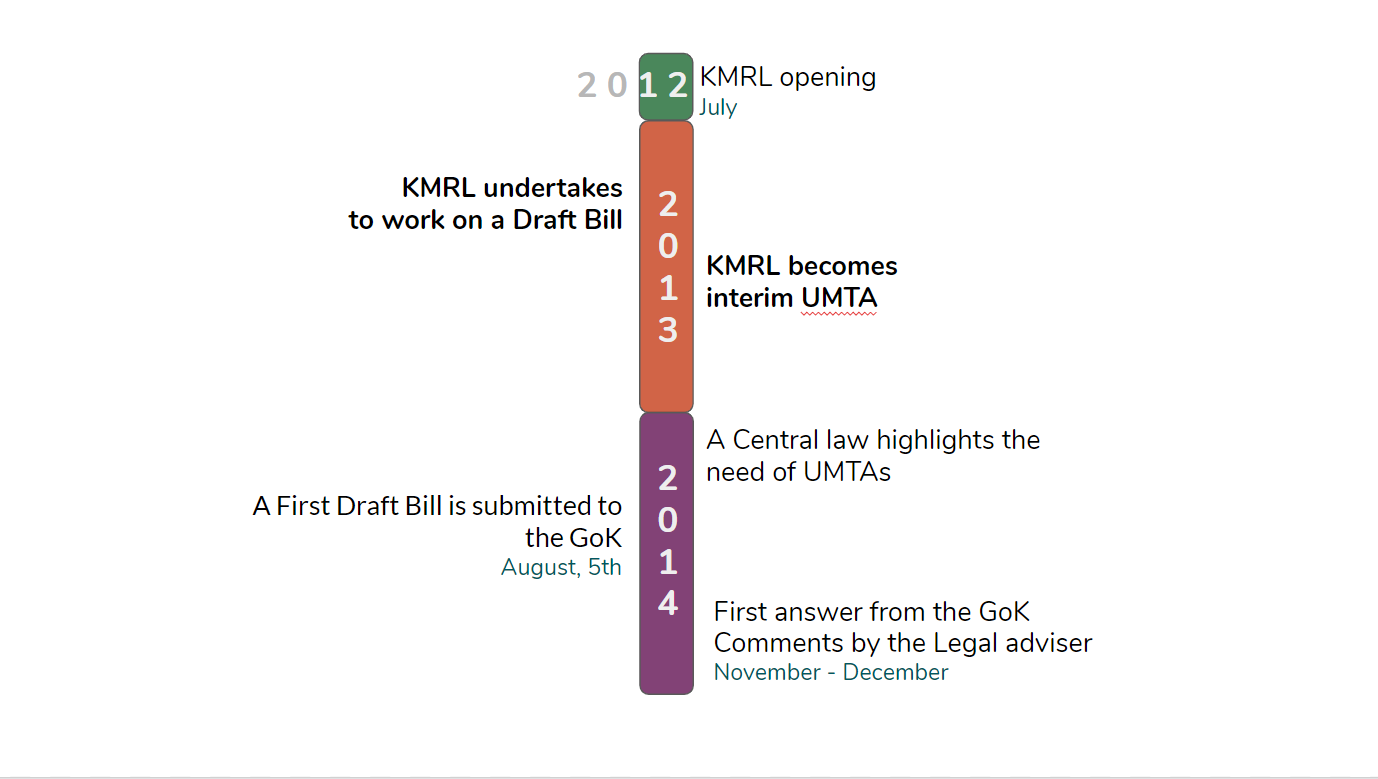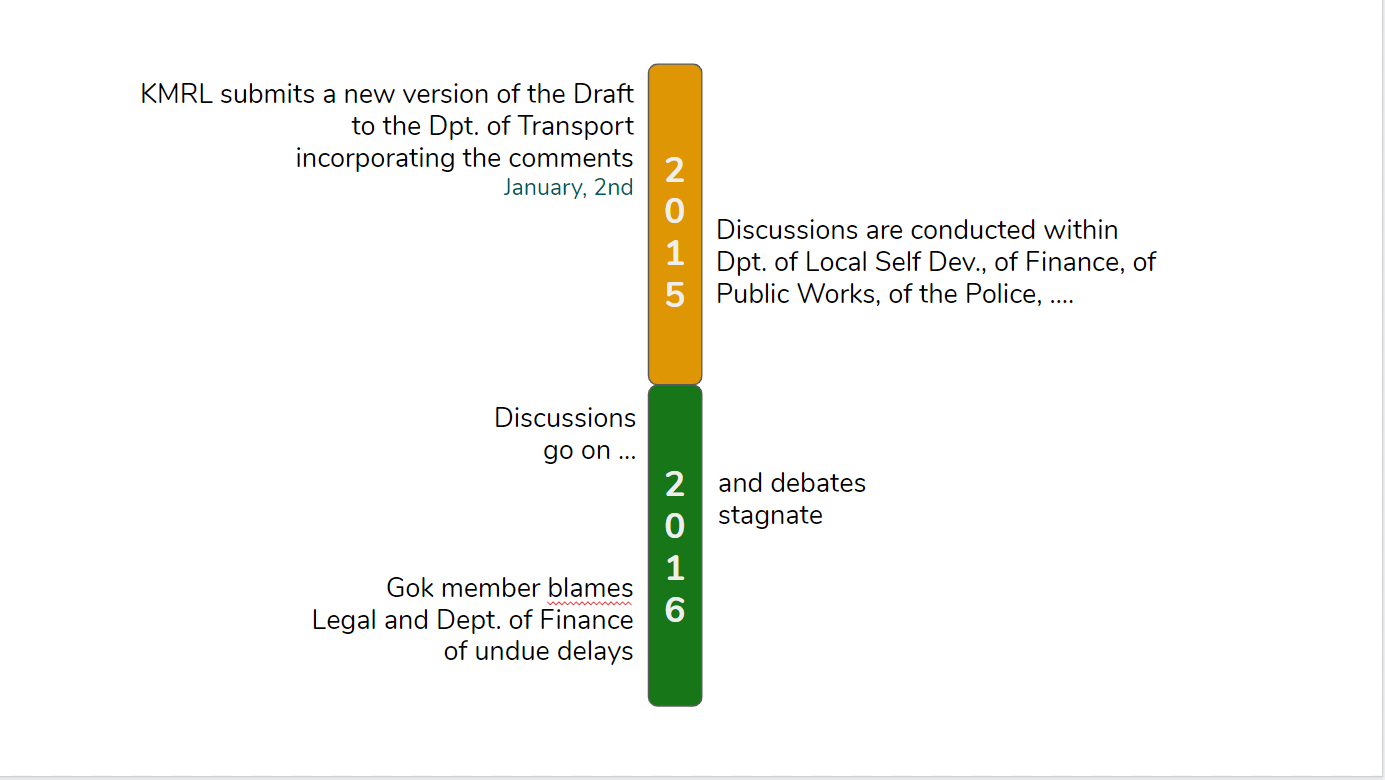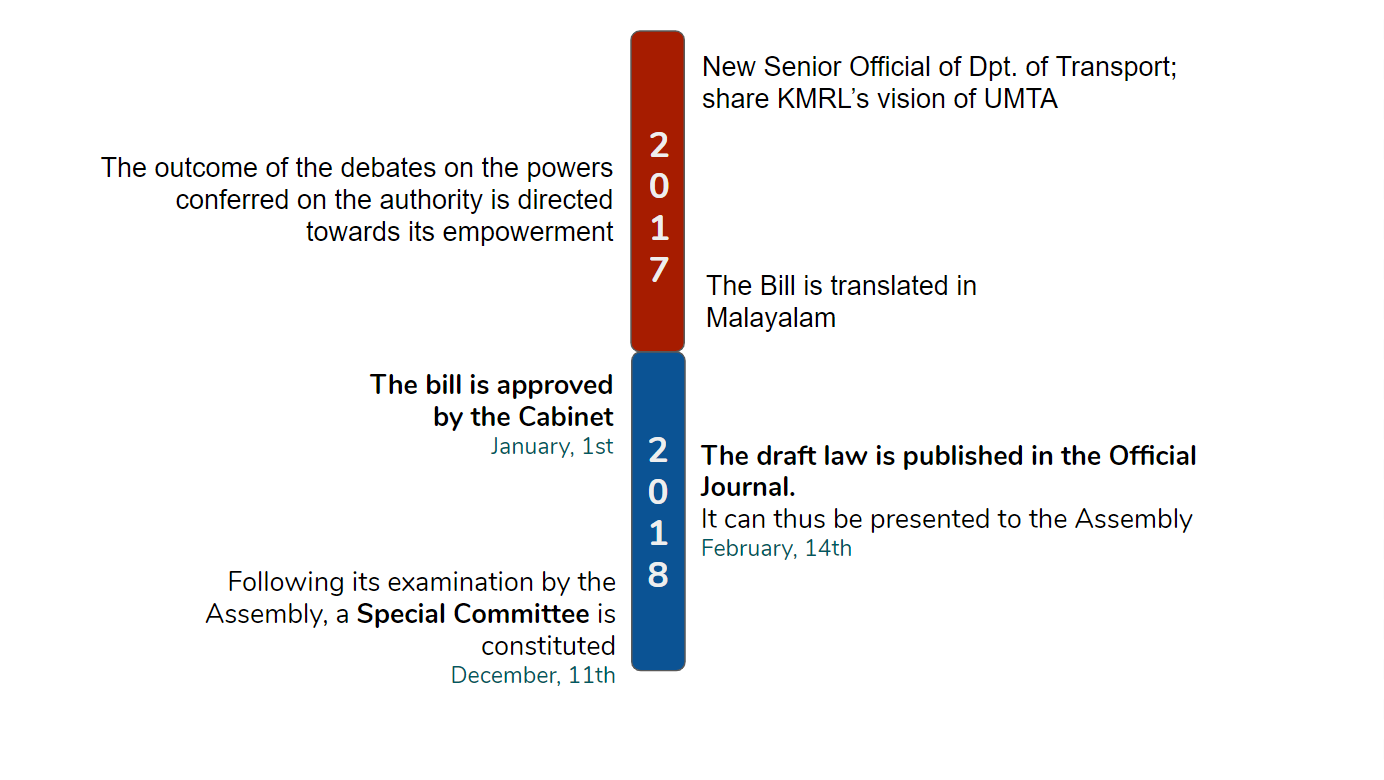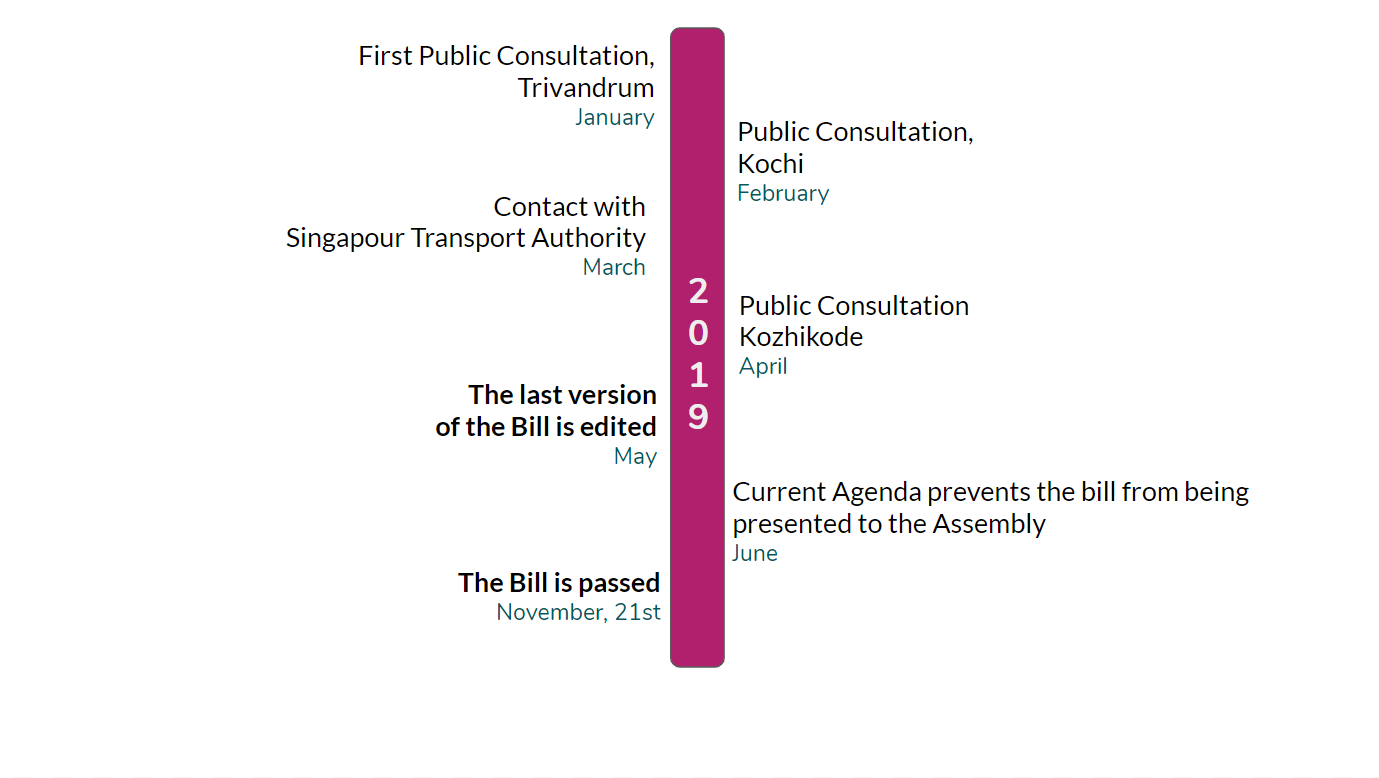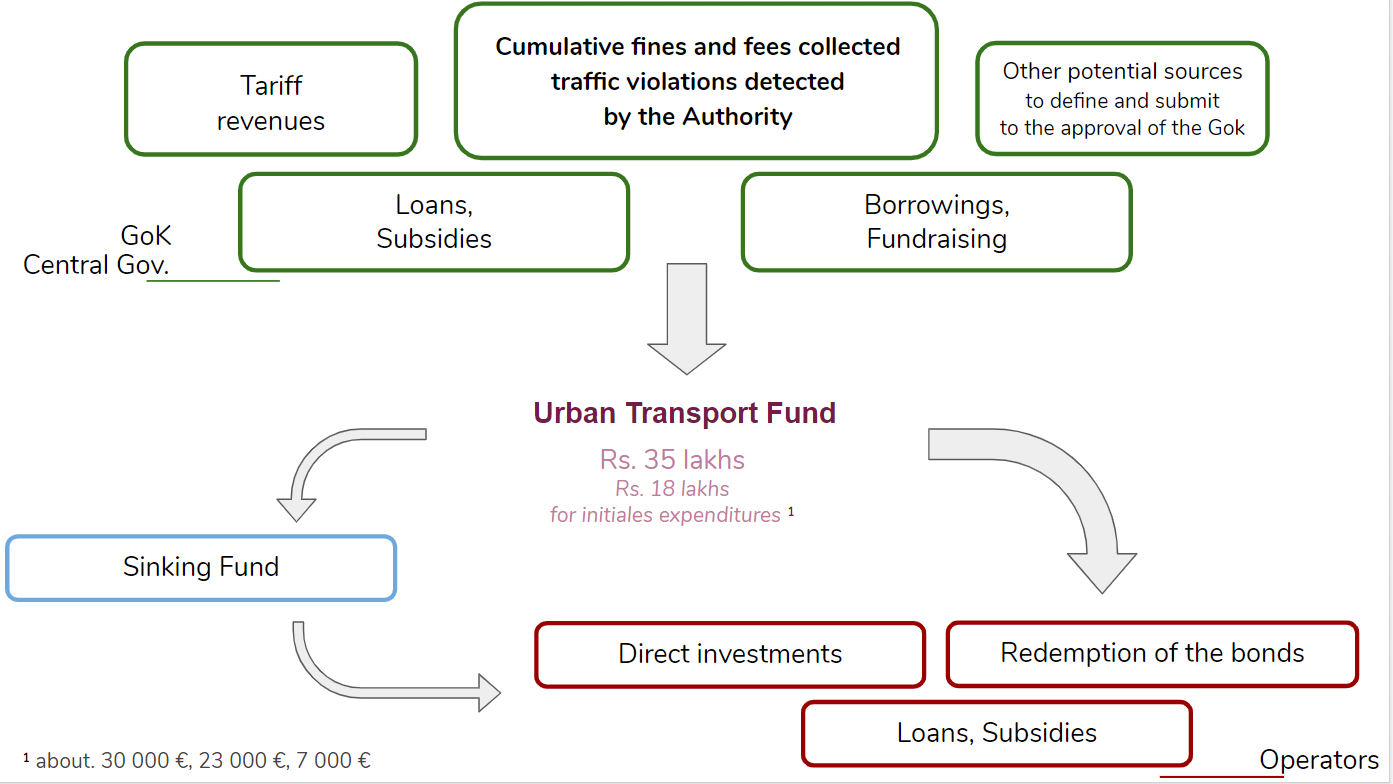5 years later, Kochi and the establishment of a Transport Authority
The city of Kochi (Cochin) welcomed in 2017 a first metro line of which Kochi Metro Rail Limited (KMRL), a public limited company, after playing the role of project owner, now ensures its operation and maintenance. The metro was implemented with a willingness to reduce the number of personal vehicles on the roads, and ultimately reverse the trend.
The implementation approval by the Central Government of this heavy infrastructure was conditional on the commitment of the Government of Kerala (GoK) to carry out various projects to promote the integration of all modes of transport available within the urban area. Since the Department of Transport of the GoK does not have a technical unit but only administrative staff, KMRL has taken the initiative to lead these various projects.
To find out more about the Kochi urban area, its metro, and other means of transport:
https://www.codatu.org/publications/monographies/kochi-inde-le-metro-locomotive-de-la-smart-city/ (Marion Hoyez, November 2016)
The publication resulting from the collaboration between CODATU and KMRL is also available: https://www.codatu.org/actualites/the-kochi-metro-experience-a-valuable-contribution-to-the-history-of-indian-metros/

Kochi Metro Rail Limited, Kochi Intermodality Leader
Since its inception, KMRL’s projects have been part of a major undertaking to review the entire urban transport system of the Greater Kochi Area, This should lead to greater coherence and complementarity between the different modes of transport.
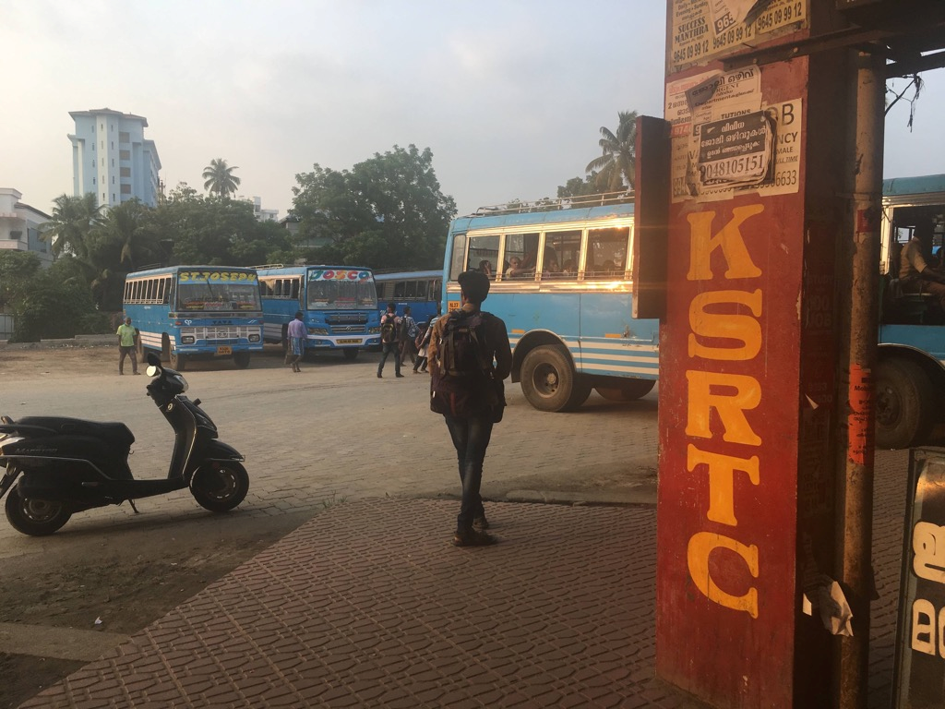
Photo d’un emplacement réservé pour les bus publics (KSRTC) au sein du terminal de bus privés d’Aluva (Grand Kochi)

Photo d’une piste cyclable entre le terminal de bus privé et la station de métro Aluva (Grand Kochi)
The case of Kochi is particularly interesting considering the diversity of means of transport which the inhabitants can access : train, public and private buses (for short, medium and long distance journeys), metro, boats, auto-rickshaws, taxi, not to mention cycling and walking. Despite the diversity of transport means and the relative performance of each of them, the network is still not conducive to multimodal travel. This can be explained by the competition between metro and bus on the main road, the non-synchronization of the schedules between the different modes, the cost of multimodal journeys and the cruel lack of passenger information on a particular mode and the complete lack of information facilitating mode transfers within infrastructures. Moreover, bulk breakings remain significant and there are still serious equipment deficiencies at terminals and metro stations to address the first and last mile connectivity (pedestrian accessibility, bike parks, rickshaw drop-off, etc.). In addition, the network still covers only 49% of the territory of the Greater Kochi and the service frequency is significantly reduced after 8pm.
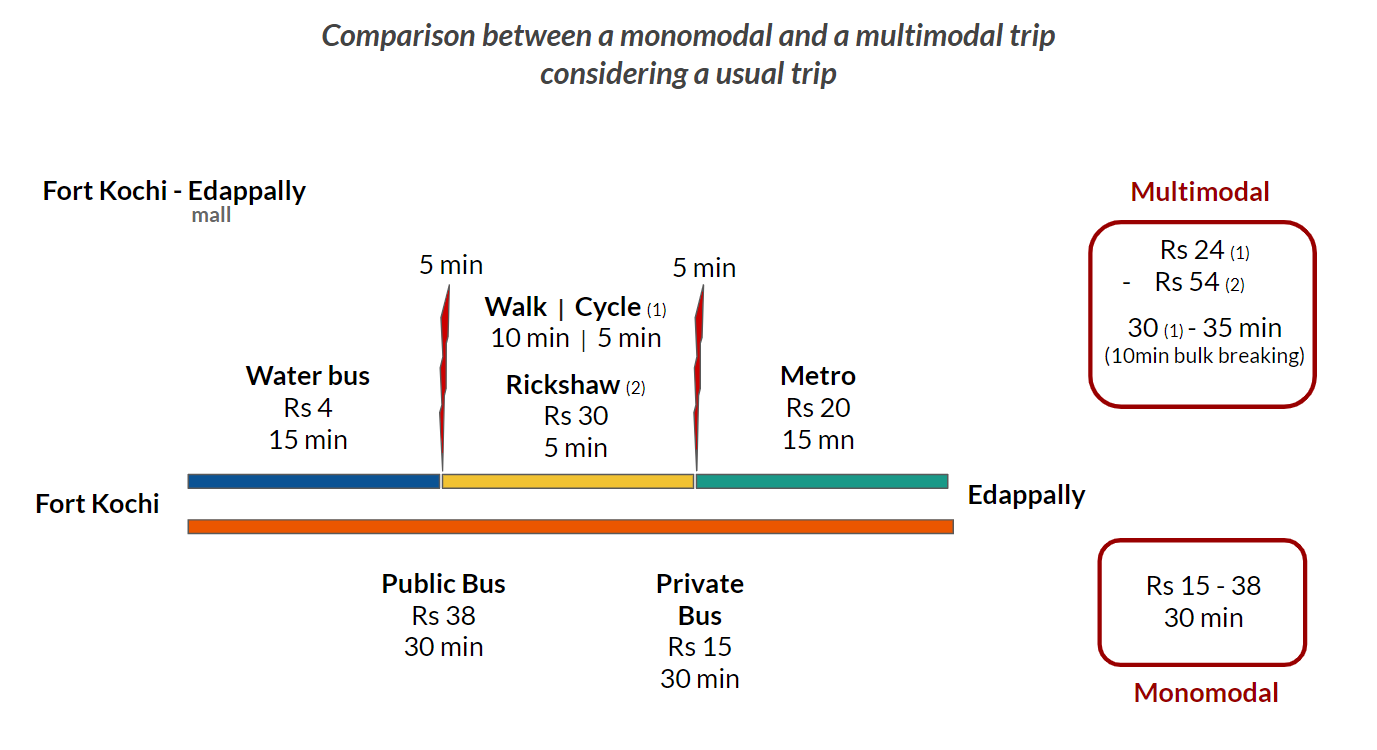
The road to implement a seamless transport network is therefore substantial and KMRL tackles it through various approaches:
- overall, through the implementation of a Comprehensive Mobility Plan as well as an Integrated Public Transport Plan which includes a number of measures aimed at rationalizing the bus network to ensure their complementarity with the metro, a “soft modes” Plan
- more specific, by undertaking, for example, projects of common ticketing for all modes, restructuring of terminals into commercial and multimodal hubs, …
KMRL also undertook to institute discussions with the various operators in order to initiate cooperative relations. This led to the creation of a union comprising all rickshaw operators facilitating cooperation with them, as well as the revision of routes of certain buses competing with the metro. The article Title, link gives further informations on the broaden collaborations.
Kochi Metro has thus asserted itself in its role of provisional Unified Metropolitan Transport Authority (UMTA), officially granted by the Indian government in 2013.

Photo d’un « pick-up point » réservé aux auto-rickshaws à l’entrée d’une station de métro
Towards intermodality: from pilot projects to the institutionalization of an UMTA
The arrival of the metro and these related projects not only disrupted the local transport market, but also led to a global reflection on the institutional landscape of the transport sector on Kerala scale, echoing national dynamics. While all Indian cities suffer from increasing congestion, the National Urban Transport Policy (NUTP, 2006) foresees the creation of UMTAs in cities with more than 1 million inhabitants in order to unify the institutional landscape of urban transport. In 2014, while the same NUTP was re-published in order to make it more usable by local authorities, Kochi was the first Indian city to embark on the adventure.
With its technical capabilities and legitimacy, while the Government of Kerala (GoK) was slow to take matters into its own hands, KMRL took the initiative to draft a regional bill laying down the legislative framework for the implementation of an Urban Transport Authority (UMTA) Bill. The law was then expected to be adopted by the end of 2016, but the legislative process has been considerably extended, and the bill was not put to the vote of the Assembly until October 2019. On May 2, 2019, the latest version of the bill was edited following a meeting at the initiative of the Head of the GoK Department of Transport and bringing together the Commissioner of Transports, the Chief of Urban Planning, representatives of the Department of Finance, the Department of Transport, the Department of Planning and Economy, the Department of Local Development, and the Legal Department, as well as members of KMRL’s Transport Planning Department.
The decision-making and content development process of the Act
After a first version proposed by KMRL, the bill went back and forth a number of times between the metro company and the government. A Special Committee composed of 15 members of the Legislative Assembly and the Minister of Transport was formed to lead the debates on the content of the text and to organize meetings bringing together all the stakeholders of transport and external “experts” (in particular Centre for Public Policy Research, a Kochi-based institute of political science and members of Singapore’s UMTA). Public consultations for each of the three urban areas to host its own UMTA (Kochi, Kozhikode and Trivandrum) were also held.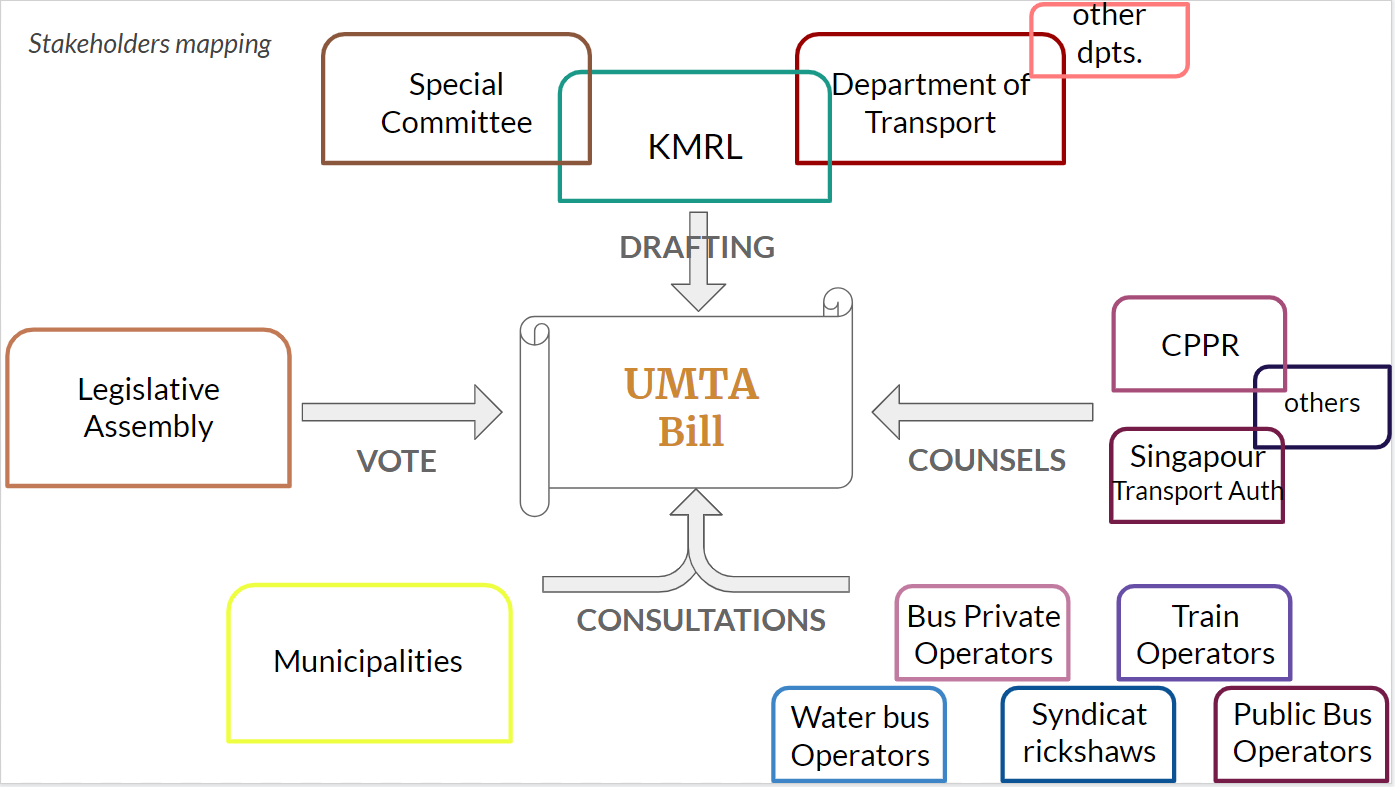
A legal framework barely favourable to welcome an UMTA
Although urban planning skills theoretically belong to the State of Kerala, through the implementation of a Development Plan for Kochi City Region by the Department of Town and Country Planning, in reality, planning issues constitute a relative “legislative desert”, which was a first difficulty to overcome. Indeed, the legislative framework in force is particularly sectorised and segregated. Like the latter, the collaboration between Greater Cochin District Authority (GCDA), the Department of Urban Planning, the Department of Transport, and the Department of Public Works (responsible with the GCDA for phasing out, implementing and monitoring projects) and the National Highway Authority of India, are almost non-existent.
«Since 1986, at the central level, the responsibility for urban transport planning rests on a single ministry: the Ministry of Housing and Urban Affairs (MoHUA). At the state level, the Department of Transport is responsible for steering transport policy. In Kerala, as in other states, there is a fragmentation of responsibilities between a multitude of institutions:
- In addition to the multitude of private operators, there are two public urban and regional bus operators: KSRTC and KURTC;
- River transport of passengers and goods is provided by two companies: KSWTD and KSINC;
- A joint venture belonging to the State of Kerala and the Central State was created in 2012 to build the metro: KMRL;
- The Indian railways that manage passenger and freight rail remain completely independent.”
(Marion Hoyez, November 2016)
Moreover, the creation of UMTAs at the legislative level is confronted with the “Motor Vehicle Act”, a central law dating from 1988, which many consider obsolete and which grants the power to plan and regulate motorized transport modes to the Regional Transport Authorities (RTAs). Since the legislation governing the creation of UMTAs is now established at national level in India, UMTAs can only have essentially consultative powers. In particular, the Motor Vehicle Act prevents the future Kochi UMTA from imposing a Bus route rationalization plan, a crucial aspect of Kochi urban planning plan in order to implement a coherent and seamless transport system. The latter will thus have only an advisory power regarding the revision of bus routes, their schedules but also of infrastructure equipment in terms of information, …
The foundations of the UMTA were therefore built on a weak basis, the major challenge being to insert a new component, that of planning involving coordinated action, within a rigid urban transport governance and a barely unified sector. The success of the creation of UMTAs, which is primarily intended to establish coherence in the transport offer, is thus essentially based on the establishment of constructive communication and collaborative relations between all stakeholders of the sector.
An organisation requiring autonomy and the problem of overlapping powers
Moreover, the definition of the division of powers between the State Department of Transport and the UMTA and more broadly the degree of involvement of the Ministry in the activities of this new authority was a real sticking point. Indeed, while the interest of the latter lies essentially in its local dimension, the nature of the suggestions made by the government has shown its reluctance to delegate and confer powers to this new entity, so much so that the government proposed earlier in the year to build an authority at a state level rather than at the city level, as reported in the New Indian Express in an article published on February 11, 2019. Its degree of autonomy from the government was thus subject to debate until the last version of the text was drafted. One of KMRL’s employees states that the arrival of a new Commissioner of Transport in 2017 largely contributed to the opening of the Department to give consistent powers to the UMT.
“ As the Scheme and UTP (part of CMP) are to be approved by the State Government before implementation, further requirement of taking up again with State Government for issuing directions, will only amount to curtailing the much needed powers of the Authority. The existing provision will result in the Authority not having powers even to issue directions to individuals. ”
D Dhanuraj, Chairman of CPPR
“The bill defines the authority in a very loose manner for its outcome part and its success is at the mercy of the state government. The authority is not independent and remit to plan and execute its decisions.”
D Dhanuraj, Chairman of CPPR
As well as the entries defining the relations between the government and the UMTA, those decreeing the division of competences and the position of the UMTA in relation to the other stakeholders of transport sector (operators, project company – in particular trading hubs, etc.) constituted a complex technico-legal exercise and were thus the subject of numerous revisions.
“Transport related developments by other organizations may lead to overlap of interests between different organizations for achieving the same objectives. Eg. Parking facility built by Municipal corporation or Highway project passing through municipal limits.”
“Even though the authority is meant for the Municipal area, the representation of the local government is confined to the secretary of the corporation and everything else left for the discretion of the state government. It fails in its own mandate at the local level by giving excessive control of the state government over its functions.”
D Dhanuraj, Chairman of CPPR
Because of its leading role in the establishment of this institution, KMRL would initially prefigurate the UMTA in kochi, the MD of KMRL being the chairman of the UMTA. It was finally decided that the two institutions should be strictly separated. In fact, if the UMTA was originally intended to bring together under one umbrella all the executive bodies and transport actors of the Greater Kochi Area, the latest version of the bill (which will be the one submitted to the vote of the Legislative Assembly in October 2019), foresees a very different structure. A fundamental aspect that has been amply debated between the various stakeholders was about the definition of the members of this UMTA: Should the institution include all the operators? the public operators? Or should they be excluded from its bodies? In other words, should the institution in essence be governed by the power relations between the different actors? Or should it be free of any conflicts of interest within it, and position itself “above” the operators? In this regard, Mr. O.P. Agarwal, Director General of the World Resources Institutes (WRI), noted that “It seems difficult to find an “expert” worthy of the name without it being associated with any urban transport business. After all, it is these organizations that provide relevant analysis. Perhaps the compromise could be to exclude operators from urban and ancillary transport, and leave the possibility of including teaching and research people and consultants.”
“UMTA is a regulatory body; not an operational one. In that sense, the executive board of the authority should be free from everyone who is part of the system. As per the current plan, managing directors of Kochi Metro Rail Limited (KMRL), Kerala State Road Transport Corporation (KSRTC), among others will constitute the core team which will raise the conflict of interest,”
D Dhanuraj, Chairman of CPPR
Finally, market participants will be excluded from these decision-making bodies, and their involvement in planning will be limited to their presence in technical departments of the future UMTA. The internal structure of the UMTA is detailed in the figure below. Nevertheless, the Chief of Urban Planning suggested at the last meeting led by the Department of Transport that KMRL be made a special member of the Urban Planning Committee.
Structure and Governance
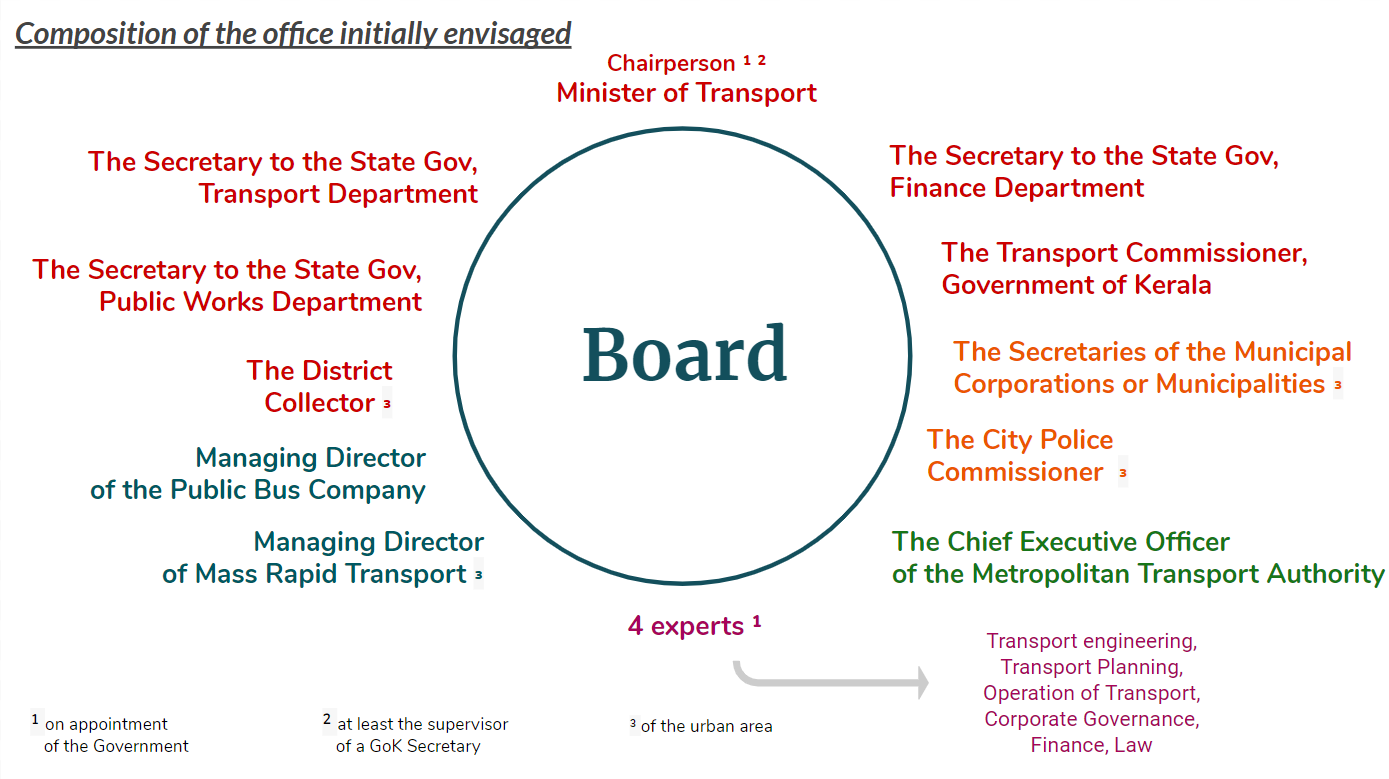
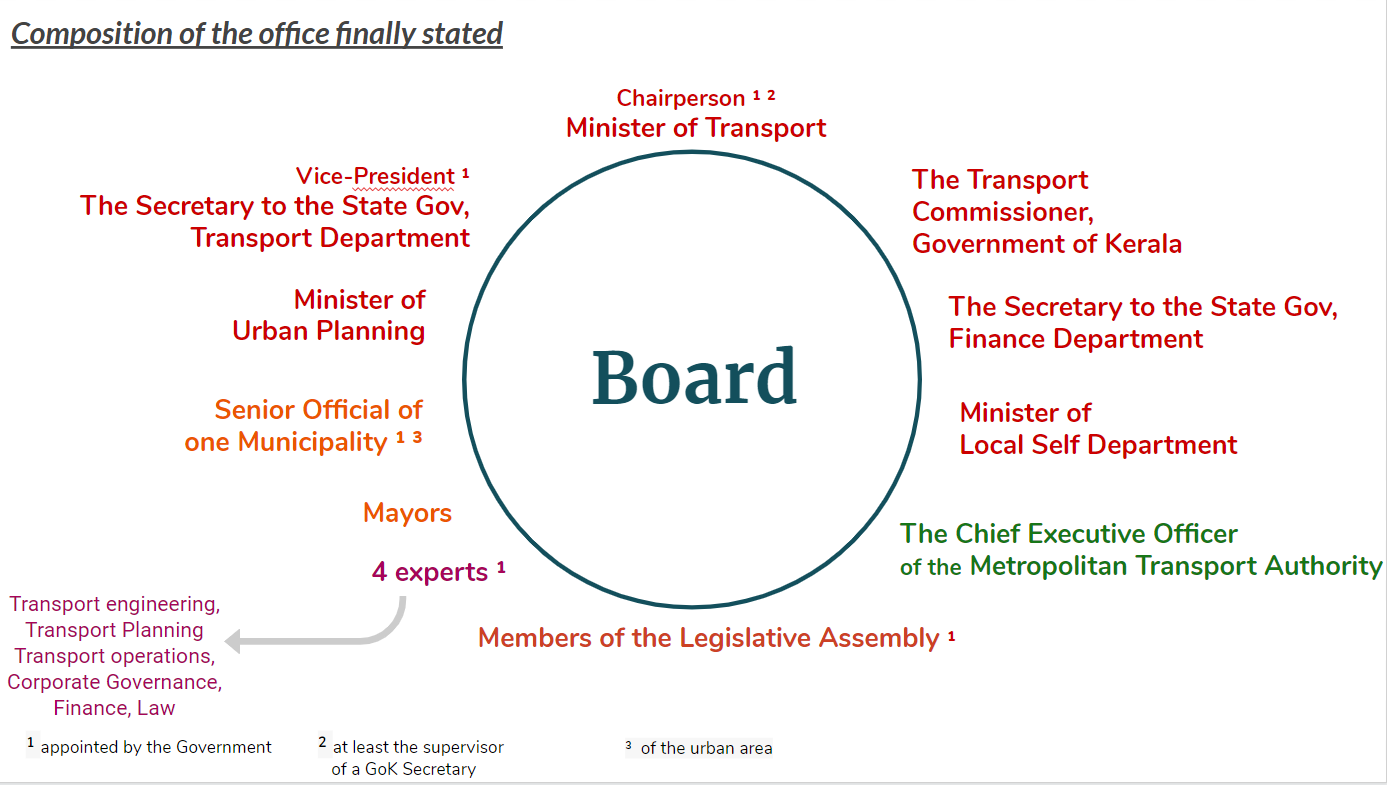
Initially, the municipal bodies were confined to an “ex-officio” status. CPPR deplored this choice, arguing, “If we consider successful Unified Metropolitan transport bodies like London and Singapore, it is the city mayor who heads the body. But here, the mayor has no role in the decisions.” Despite UMTA’s scale of action, local authorities were the least represented in the governing body, which could affect the management and facilitation functions of the authority, according to a former councillor of the municipality of Kochi.
After many discussions, the choice was finally made to put the municipalities at the heart of the decision. Hence, mayors and a Senior Official of one of the municipalities concerned, the Minister who represents them at the level of the Government of Kerala (Minister of Local Development) are part of the decision-making body.
Moreover, the board envisioned in the first phase was characterized by a lack of representation in the field of urban planning… If it has finally been integrated, the absence of representatives from areas such as the environment, energy, etc. can be noticed. The integration of experts from such fields within the office had been suggested by CPPR but was ultimately not retained. This may be regarded as regrettable in the light of the explicitly pursued objective of sustainable development and the interlocking of each of the problems it includes. The presence of such experts in the institutions’ bodies could give rise to a real dynamic in the conduct of studies on air quality, socio-demographic impacts and other work related to urban mobility. Nevertheless, this type of actors, operators as well as representatives of institutions such as the Police, the National Road Agency, etc. may be represented in the UMTA technical departments.
Powers & Functions
The CPPR Institute for Research on Public Policy has repeatedly identified a lack of clarity in defining the role of the authority. Moreover, the clear and indisputable granting of binding powers to the UMTA for the implementation of its programmes was confronted to the reluctance of the Government.
“The Bill is ambiguous in defining the nature of the authority; is it a regulatory body or an implanting agency or a provider. The Authority should be regulatory in nature for better and effective coordination and implementation, but the stated provisions are misleading in its definitions.”
Nevertheless, UMTA should finally enjoy complete autonomy in the projects it undertakes. State intervention should indeed be limited to the approval of potential changes in internal policies and its budget and the organisation should be able to exercise the powers of a pilot and planning entity and to implement programs such as single ticketing system for all means of transport, and development of a parking policy for the urban area. Despite the recommendations of the World Resources Institute, the management of a common database for all public transport does not appear in the legislation. This will not prevent UMTA from developing this major tool in establishing coherent planning in a second phase and setting up a control centre grouping all modes and the development of “ITS” (Intelligent Transport System).
The autonomy of each UMTA (Kochi, Kozhikode and Trivandrum) will also be strengthened by the establishment of a fund specific to each one: the Urban Transport Fund (UTF). The initial versions of the text have been criticized as being too rigid with respect to the definition of this fund and the nature of the sources of funding. Finally, the UTF should operate as follows.
Conclusion
After five years of drafting the law, the creation of an UMTA for Kochi and the two other urban areas of Kerala is thus about to be implemented. If the definition of the content of the law has been slowed down by the relative mistrust expressed by the Government of Kerala, this long time has enabled the construction of a law whose relevance and comprehensiveness have been praised by the Director General of the World Resources Institutes (WRI).
CPPR is nevertheless concerned by the lack of elements regarding the sharing of competences with the Department of Motor Vehicles, which plays a leading role in the reorganisation of the entire transport offer because of its competence to regulate all motor vehicles, and in particular buses. In this regard, a senior official within KSRTC commented, “Since many Kochi roads have already been nationalized, the regulation and rerouting of KSRTC services will constitute a major impasse before the authority.”
The Managing Director of WRI, meanwhile, identified weaknesses in the identification of its financing methods. He recommends a commitment by governments to make a substantial subsidy or to grant the UMTA additional levies – such as a capital gains levy or value added tax levies. He also recommends the UMTA to be considered as a central organ of all funds for urban transport.
Other grey areas remain to be clarified as to the concrete establishment of this new authority and its organisation, in particular the definition of the various services within it. Most of them should be subjects of decrees. According to comments from experts from a variety of backgrounds, weaknesses in the organisation’s structure and its role could be problematic. The perimeters of the areas under the authority of each of the three UMTA will be recorded by publication in the Gazette. They will be subject of debate already tense with respect of the underlying governance issues and the interest in extending the area under the authority of the UMTA beyond the borders considered by the administration in order to define relevant perimeters with regards concrete mobility issues. In addition, the text provides that potential disputes between UMTA and other stakeholders, including those relating to the exercise of its powers, should be resolved by the GoK.
Finally, the main obstacle to an organisation bringing together the wider range of mobility stakeholders remains the “Motor Vehicle Act” and more broadly the inertia at the central level to establish coherent legislation and respond to the current challenges of mobility. Indeed, without the coercive powers that would allow it to constitute a real regulating body and to position itself as a true planning authority, the Unified Metropolitan Transport Authority, which are provided for in the National Urban Transport Policy (NUTP, 2014), will remain secondary entities, mainly advisory. KMRL’s Transport Planning Department is persevering and is currently working unofficially on proposed amendments to the Motor Vehicle Act. and undertook the elaboration of a central law facilitating the implementation of UMTA for all Indian metropolises ! It is also currently in close cooperation with the Department of Transport of the Government of Kerala, with which it is working to establish a technical service within the latter.
Thus KMRL has engaged an ambitious, which it leads conscientiously and with determination. This dynamic maintained by KMRL on the Kerala scale is remarkable and has not failed to be the object of all attention, beyond the borders of the State.
Kochi, the first Indian city to establish a single authority to lead the planning of all urban transport, thus demonstrates its capacity to undertake and innovate, and opens the way for a new transport organisation, for a more unified, complementary, coherent network and more sustainable mobility.
Author : Judith SZABATURA – Project Assistant – ENTPE civil engineering student
